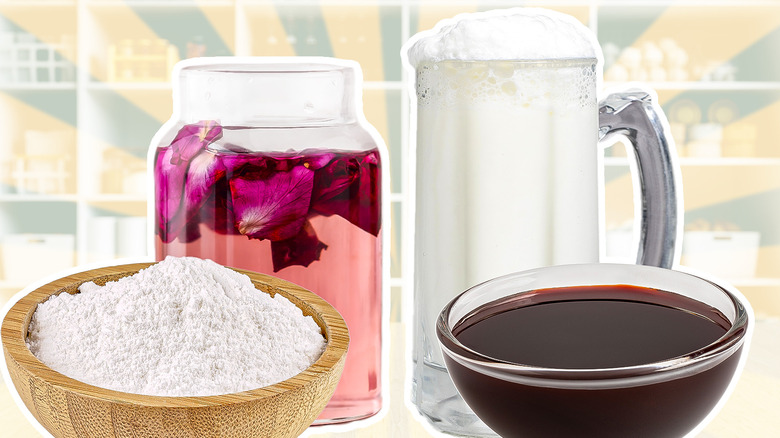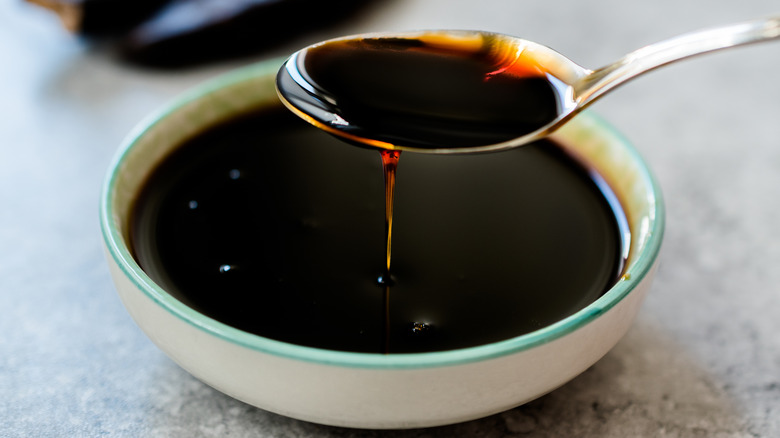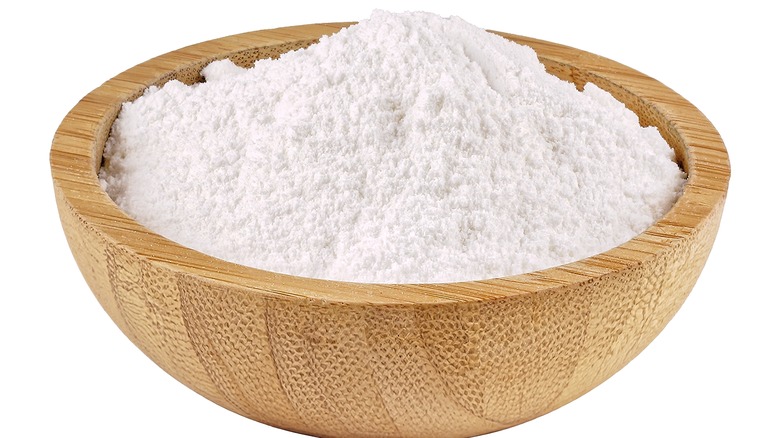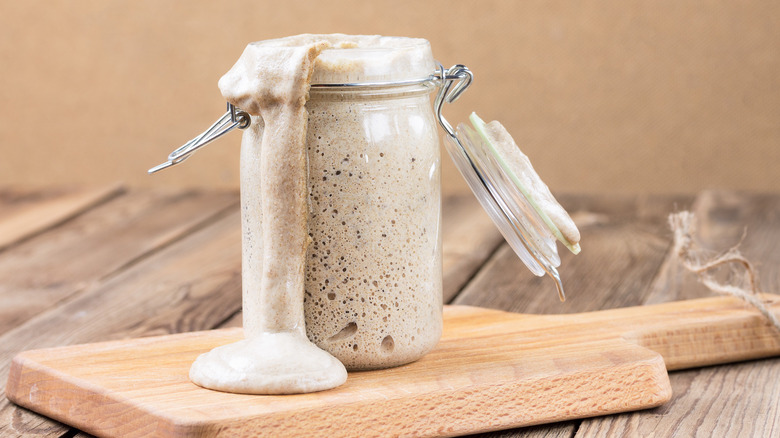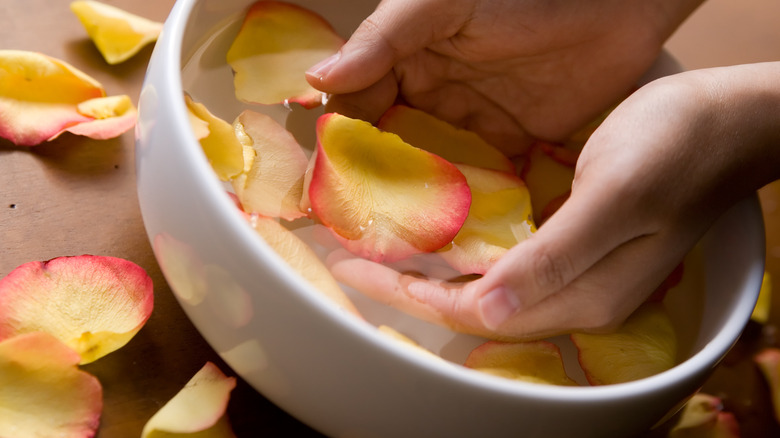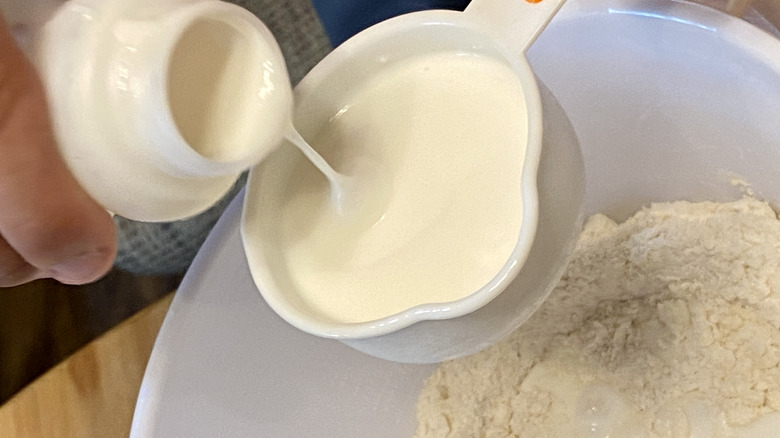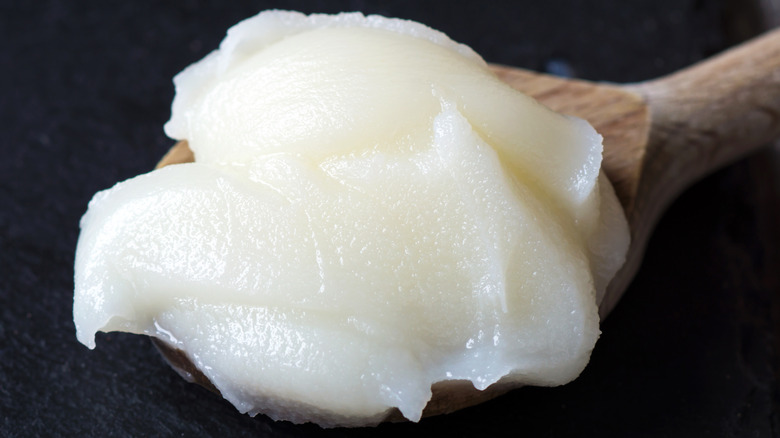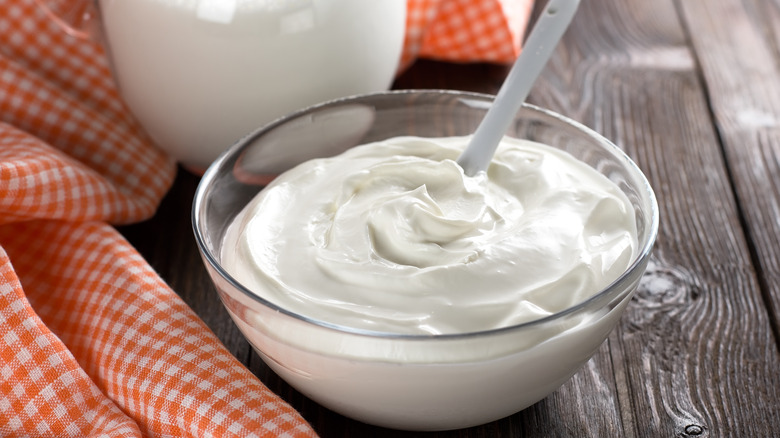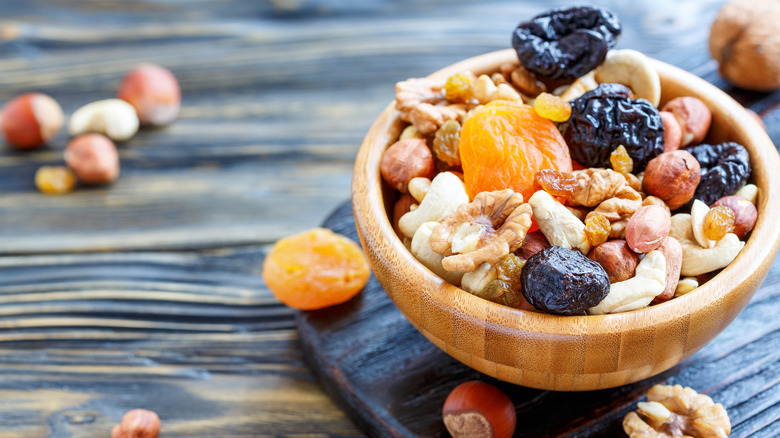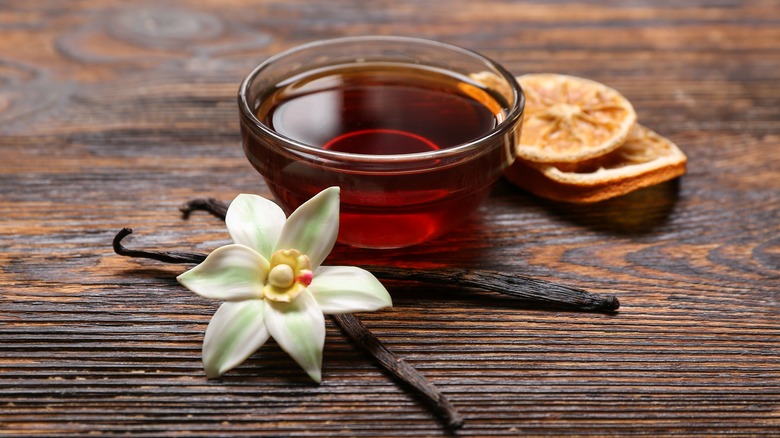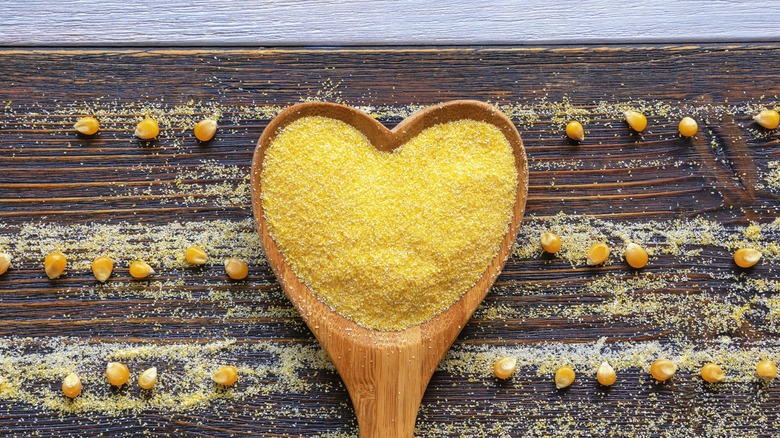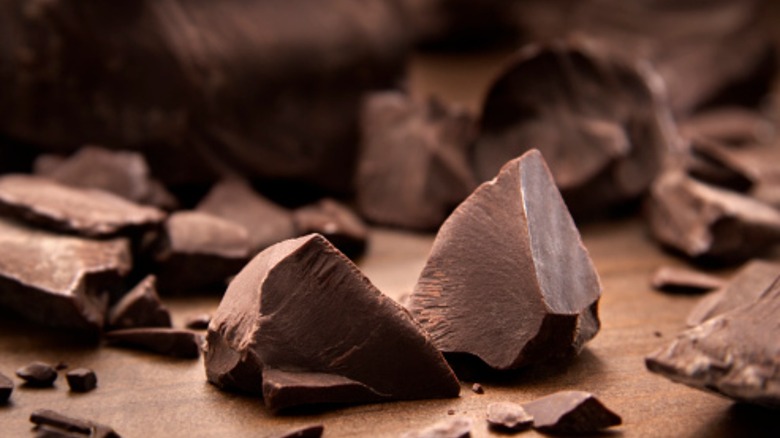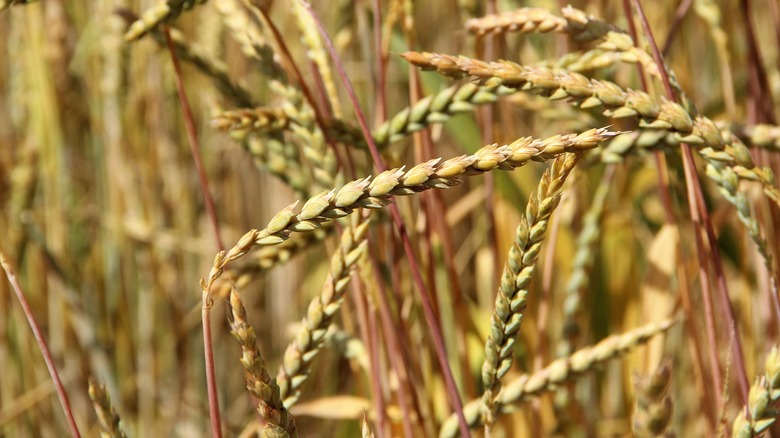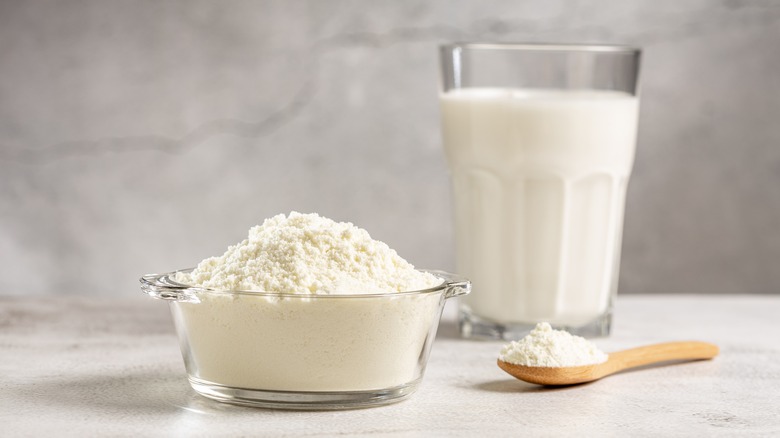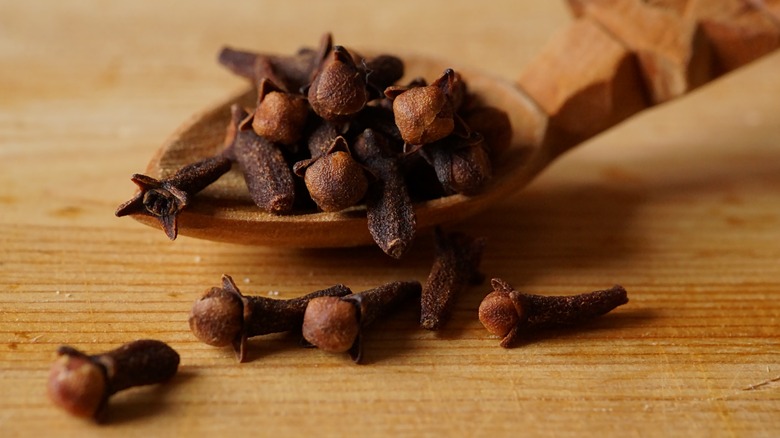14 Old-School Baking Ingredients You Need In Your Pantry
Trying out an old-fashioned baking recipe makes for an amusing experience. There's always something new to discover, and utilizing uncommon ingredients is part of the fun. Old-school baking ingredients may not crop up very often in modern-day recipes, but that doesn't mean they don't have a purpose. As you'll soon discover, there are many ingredients that have stood the test of time that would work to upgrade your baked goods and even impart flavors that you never knew existed.
To broaden our understanding, we consulted some experts to share their thoughts about which old-fashioned baking ingredients — from flavorings to mix-ins and even a few surprises in between — many of us have been missing out on. We're confident you'll learn a thing or two you didn't know before that you can incorporate the next time you find yourself baking in the kitchen.
Join us as these experts fill us in about the old-school baking ingredients you need in your pantry.
1. Dark molasses
When it comes to old-school baking ingredients, molasses tops the list. Molasses carries with it a variety of uses and can trace its origins to at least 500 B.C. in India. The thick, dark syrup was a common commodity for baking in the U.S. before it was eventually overshadowed by refined sugar after World War I. Despite this decline in popularity, molasses remains a delicious and uniquely flavored sweetener that you can incorporate into your baked goods even today.
We spoke with Jessie-Sierra Ross, food blogger at Straight to the Hips, Baby and author of Seasons Around the Table, who gave us a few additional facts about this syrupy old-school ingredient. "Sweet, viscous, and full of vitamins, dark molasses lends a rich caramel-like flavor when used in baking. A byproduct of sugar production, this twice-boiled thick brown syrup is considered 'the leftovers' from refining cane sugar," she states.
Today, molasses can be utilized in recipes like chewy molasses spice cookies, holiday-inspired pecan praline gingerbread cake, muffins, and more. And though it's delicious, be careful not to substitute molasses for refined sugar without understanding the effects. Molasses is strong and has a very distinct taste, and as such, you'll need to use it wisely to prevent its flavor from overpowering your baked goods.
2. Cream of tartar
Though its use in cooking dates to at least the 1700s, cream of tartar first became popular among the French in the 1800s. As knowledge of the properties of cream of tartar spread, various recipes were developed that gave way to many of the scrumptious desserts we know today.
So, what is cream of tartar, really? Food blogger Jessie-Sierra Ross explains: "Made from the byproducts of wine-making, cream of tartar is also known as potassium hydrogen tartrate. An organic food stabilizer, it's often used to stabilize airy confections like meringue and macarons." She adds that this old-school baking ingredient works to create structure between the small air bubbles of the egg whites in these desserts. Even so, there are even more ways to use cream of tartar in baking outside of your standard meringue. Other recipes, like snickerdoodle cookies, also benefit from this ingredient, making them delightfully tangy and chewy.
Oh, and in case you're wondering, cream of tartar isn't actually a cream. It is an odorless, white powdery substance that can be sprinkled in with your dry ingredients when baking. Now you know!
3. Sourdough starter scrap
Before commercial yeasts came into existence, all bread was essentially sourdough. In recent times, sourdough has seen a resurgence in popularity, especially given its purported health benefits. If you've hopped on the sourdough train, you likely know all about sourdough scrap. If you don't know, sourdough scrap, also known as sourdough discard, is the portion of sourdough starter that is left "unfed" during the maintenance process. Of course, in order to get your sourdough discard, you'll first need to make your from-scratch sourdough starter.
To make sourdough starter, you'll need only two ingredients — flour and water — plus plenty of time. You'll measure these ingredients and follow a simple yet methodical strategy that involves feeding and discarding parts of your starter over multiple days. The unfed portion of your discard is what you can use to make a variety of baked goods. "Add a 1/4 cup of starter to your next scone recipe for tender, flaky pastry or the same amount to your next pie crust," food blogger Jessie-Sierra Ross recommends. "The sourdough starter adds a lovely tang to cookies, pancakes, and quick breads. It keeps them nice and moist too."
4. Rose water
Rose water in baking? Yep, it used to be a thing. Apparently, this was a very common ingredient in the 19th century, and even today, Middle Eastern cultures still include it in a host of dishes. Recipes like Turkish delight utilize this uncommon addition in much the same way vanilla extract is used in American culture. Food blogger and author Jessie-Sierra Ross explains: "In the days of dried spices and not much else, bakers delighted in the classic, yet exotic flavor of rose water. Delicately floral and used in everything from sweet desserts to hand creams, rose water is a lovely way to bring the scent and taste of roses to your baking."
According to Ross, rose water is best made with organic rose petals that haven't been exposed to pesticides. These rose petals get steeped in water before being put to use in a variety of recipes. And though Ross specifically lists baklava, French madeleines, and macarons as baked goods that are often made with rose water, other more casual recipes, like cakes and muffins, can benefit from this uncanny ingredient as well.
5. Buttermilk
Buttermilk, though still commonly used in Southern cooking, is another old-school ingredient that could benefit your baking. It's a cultured milk similar to yogurt that has a distinct flavor profile perfect for certain eats. "It adds a beautiful tang and moisture to baked goods, making pancakes, biscuits, and cakes incredibly tender," explains Jessica Randhawa, a chef and food blogger with The Forked Spoon. "I often use it as a substitute for regular milk in recipes to enhance the flavor and texture."
As far as where to grab buttermilk, you can usually find it in the dairy aisle, next to the regular milk, at most grocery stores. Also, because buttermilk is usually sold in jugs or cartons, you may find yourself with too much of it left over after using it in a recipe. Rather than throw it out, it's best to figure out a few awesome ways to use leftover buttermilk. It has so many creative culinary uses that keeping this ingredient on hand just makes sense.
If you truly don't want to buy a whole carton of buttermilk that will leave you with leftovers you can't use, you may wish to try The Pioneer Woman's simple buttermilk substitute. Doing so will yield just the right amount of makeshift "buttermilk" you need without leading to waste.
6. Lard
Lard isn't an ingredient you'll hear much about these days, which is one of the reasons it lands here on our list of old-school baking ingredients you need in your pantry. For those of you who aren't familiar with it, lard is 100% animal fat that is often derived from pork. A little over a century ago, lard was the preferred baking fat of its time. Butter has since taken its place, but that doesn't mean you can't make use of its benefits. Chef Jessica Randhawa elaborates on the reasons you should start using lard when baking. "Using lard might sound old-fashioned, but it can make pie crusts and pastries exceptionally flaky and tender," she says. "Unlike butter, lard has a higher melting point, which helps create those lovely layers in your dough. It's definitely worth trying if you want to achieve the perfect crust."
Of course, it isn't only pie crusts and pastries that benefit from the use of lard; it also works well in biscuits. And though it's a rare event that you'll find a biscuit recipe that includes lard as part of its ingredients as written, there are some out there, like this one for bacon-cheddar biscuits from the 2010 book "Pig: King of the Southern Table," by the late food writer James Villas, that details how to pull it off.
7. Sour cream
Like buttermilk, sour cream is often considered an old-fashioned ingredient in baked goods that, surprisingly, boasts several advantages when added. "Sour cream is fantastic in cakes and muffins. It adds moisture and a slight tang that complements the sweetness," states Dennis Littley, a classically trained chef who shares his culinary knowledge on the food blog Ask Chef Dennis.
Unsure of how much sour cream to add? It will depend on the recipe but could range from a half a cup, like in this coffee cake, to a full cup, like in this blueberry-lavender coffee cake. In addition to cakes and muffins, cookies can also benefit from the tanginess of sour cream. Old fashioned sour cream sugar cookies are a great example and yield incredibly rich results.
Baking with sour cream works because of its high fat content, which shortens gluten strands and makes for a more tender bite. Even so, this isn't true only with sour cream. The concept also applies when adding fat in any form, including lard and butter. Because of this, it may be wise to skip non-fat versions of sour cream when baking. Though low-fat versions will likely still work, non-fat varieties might not yield the same results.
8. Nuts and dried fruits
Nuts and dried fruits are classic additions to baking, though some might be deemed a bit more old-school than others. Almonds, for example, have taken the stage as an integral part of modern-day baking, but other nuts, like pecans, may remind us of baked goods of the past. This doesn't mean that your grandmother's old-fashioned pecan pie recipe is no longer valid. It is! Actually, there are plenty of updated versions of this classic, including recipes like chocolate pecan pie.
If pecans aren't your thing, don't worry. There are other options. Chef Dennis Littley explains the significance of baking with different nuts and dried fruits as well as the benefits they add to desserts. "Keep a variety of nuts (like walnuts, pecans, and almonds) and dried fruits (such as raisins, apricots, and dates) on hand," he recommends. "They add texture, flavor, and nutrition to your baking."
Other recipes that work well with dried fruit and nuts include granola bars and oatmeal raisin cookies. Shredded coconut also serves to add texture and taste, imparting a buttery and distinct tropical flavor to traditional baked goods. If you want even more ideas, check out these 27 dried fruit recipes to sweeten up your life.
9. Pure vanilla extract
We know from experience that it is often tempting to buy lower-priced ingredients when it comes to baking — especially if you bake often. Still, when it comes to vanilla flavoring, cheap isn't always ideal. "Invest in good quality vanilla extract," chef Dennis Littley implores. "It makes a huge difference in the flavor of your baked goods compared to the imitation stuff."
In case you're wondering about the difference between imitation vanilla extract and pure vanilla extract, allow us to explain. Pure vanilla extract is made from real vanilla beans while imitation vanilla extract is either synthesized in a lab or made from wood pulp. Imitation vanilla is often less inexpensive but also is weaker in flavor. Because it contains only synthetic vanillin, it isn't as robust as pure vanilla extract.
Consider reserving pure vanilla extract for baked goods that truly will benefit from it, especially given vanilla's hefty price point. It seems vanilla extract is found in so many recipes where it may not be necessary, while some recipes, like classic New York cheesecake, simply won't taste as good without it.
10. Cornmeal
Cornmeal has deep roots in Native American and African cultures and has since graced our breakfast and dinner plates in a variety of forms. Even so, cornmeal is no longer as widely used, especially when it comes to baking options other than the ever-popular cornbread. While not as common as it once was, cornmeal can still be used for plenty of other baked goods. According to chef Dennis Littley, this ingredient can create a great texture when added to cakes and cookies.
With that said, the textural difference is something worth noting when baking with cornmeal, especially if you've never baked with it before. When using cornmeal to make cookies, always consider using half cornmeal and half flour rather than omitting the flour altogether. While using only cornmeal might technically make your baked goods gluten-free, using cornmeal as a 1:1 replacement for flour could result in strangely gritty and unappetizing cookies.
11. Baking chocolate
If you're a chocolate lover, you'll be glad to know there's a way to achieve awesome chocolatey baked goods using one simple old-school ingredient: baking chocolate. "Keep both unsweetened and semi-sweet baking chocolate in your pantry," chef Dennis Littley suggests. "Real chocolate gives a much richer flavor than cocoa powder alone."
And though this sounds great, some may wonder exactly how baking chocolate is any different than the regular sort. As mentioned, baking chocolate comes in several forms, including unsweetened and semi-sweet. The difference lies in the amount of cocoa contained in each. Moreover, baking chocolate types tend to get sold in large chunky solid bars that are meant to be chopped up and added to recipes. Regular "candy bar" style chocolate will typically be in another section of the grocery store entirely and marketed as a thinner and easier-to-eat snack.
One more thing we'd like to note about baking chocolate is that the unsweetened sort will be just that — unsweetened. This means you're going to get a very bitter albeit pure chocolate that contains no added flavors, milk, stabilizers, or sugar. This kind of chocolate should be added only to recipes that call for it, as these recipes typically contain enough sugar to counteract the chocolate's bitterness.
12. Spelt, rye, and barley
Spelt, rye, and barley are ancient grains that can be incorporated into baking -– with caveats. Ancient grains are usually less processed than modern grain types and have not undergone any genetic engineering or hybridization. And though they may bring a different element to baking than what you're used to, not all of it is bad as long as you know what to expect. "[Spelt, rye, and barley flour] were commonly used in the past and bring a nutty, robust flavor to bread, muffins, and cookies," states chef and food blogger Jessica Randhawa. "They also offer more nutritional value than refined white flour, adding fiber and protein to your baked goods."
In terms of differences when baking, each ancient grain will have its own unique characteristics. Spelt, for example, is sensitive to over-kneading, which can yield crumbly results. Rye flour, on the other hand, contains very little gluten and works wonderfully in cookies, cakes, and biscuits. For beginners, it might be best to stick with proven recipes already containing these grains until you get the hang of how they behave. Salted chocolate-rye cookies might be a fantastic recipe to start with, though there are countless others using ancient grains available to try as you feel ready.
13. Powdered milk
While milk continues to be a staple in most baked goods, dry milk isn't quite as popular. Developed in the 1800s, dry milk is known for its easy-to-store properties. And while it makes for an awesome emergency food staple in your pantry, it also is an excellent replacement for liquid milk. "Dairy is essential for most of your baking needs," states Rena Awada, owner and head chef at Healthy Fitness Meals. "Whether it's milk in your fridge or powdered milk in your pantry, you will need dairy for richness and leavening."
So, why should you be baking with milk powder? The answer lies not only in longevity but also in taste and texture. Shockingly, milk powder might stand to add even more flavor to your baked goods than regular milk. This is because milk powder is more concentrated as it contains no liquid. As a result, you'll get all the flavor in a more robust way, which can make a difference in your baked goods. Additionally, milk powder can enhance texture, leading to chewier cookies and tender bread.
14. Cloves and other warming spices
Last but not least, try enhancing your baked goods with warming spices. Cinnamon is a modern-day favorite used in many recipes, but for something old-fashioned that still packs tons of flavor, it might help to try nutmeg, ginger, or anise –- to name just a few. Chef Rena Awada explains: "Some classic spices that have been used in baking for generations add warmth, sweetness, or nutty flavor. Spices add layers of flavor and are essential in baking because they work as flavor enhancers, add aroma, and improve appearance."
Awada notes that certain spices work best for specific recipes. Nutmeg, for example, performs well in spice cakes, donuts, and pumpkin pie. It can also seriously elevate the flavor profile of chocolate chip cookies. Awada also recommends using cloves in baking, but only in small amounts due to its potency. This spice often works best in recipes like gingerbread, fruit cakes, and spice cookies. Cardamom, another beautifully flavored spice, is also recommended; it adds a sweet and floral taste to cookies, cakes, and holiday bakes.
